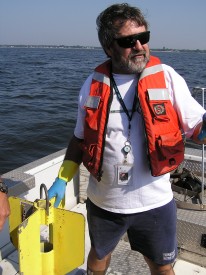
PI: Warren Boothman (EPA)
Description: With the assistance of the Waquoit Bay Reserve, staff from the Atlantic Ecology Division of the U.S. Environmental Protection Agency’s National Health and Environmental Effects Research Laboratory are examining the relationship between the frequency of hypoxia (low dissolved oxygen) in marine waters and accumulation of molybdenum (Mo) in sediments underlying those waters. Previous research in Narragansett Bay (RI) has shown that Mo accumulates in sediments when the water above becomes low in oxygen and revealed a linear relationship between the total period of hypoxia and concentration of Mo in surface sediment. To test whether the relationship is valid over a wider spatial scale, the same analyses are being done at monitoring sites within Waquoit Bay that have more than a decade of water quality data. Research chemist Warren Boothman (EPA) and Chris Weidman, Research Coordinator at the Waquoit Bay NERR, collected 12 sediment cores from 4 sites in May that will be sliced into 1-cm thick sections and analyzed for Mo. Results of the chemical analyses will be combined with historical records of dissolved oxygen to determine whether the Mo-DO relationship found in RI is also valid in coastal water bodies in MA and presumably elsewhere. In addition to examining the Mo-DO relationship in recent years, vertical profiles of Mo in the cores could develop a historical perspective on the frequency of hypoxia in Waquoit Bay.
For more information on this research, contact Warren Boothman (401-782-3161, boothman.warren@epa.gov).

